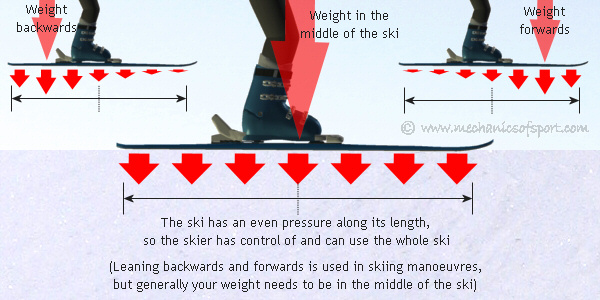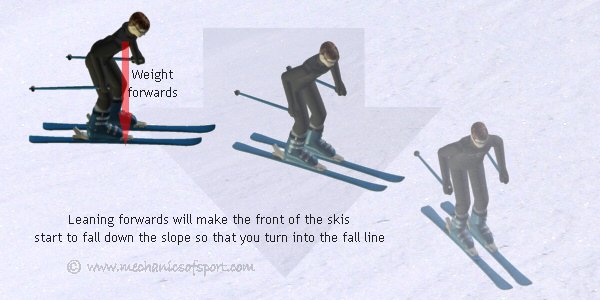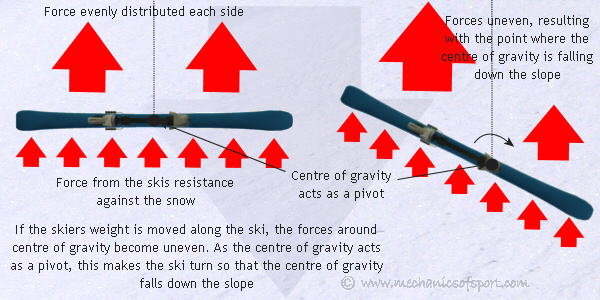Longitudinal Weight Distribution
Generally your weight should always be in the middle of the ski lengthways. For the explanations on this site, you should assume that your weight is always supposed to be in the middle of the ski, unless it tells you otherwise.
Middle of the Skis
The edges of the skis are where most of our control comes from, and to use the edges properly we must push them into the snow evenly along their length. This means that we need our weight in the middle of the ski, otherwise our weight will not be distributed evenly. If you look at a pair of skis carefully you will notice that the bindings are set back from the middle, making it necessary for you to lean forward to get your weight to the middle of the ski. The bindings are set back a bit on the ski because when you are leaning forwards pushing on the front of the ski boots, it transmits your inputs to the ski better, and makes you bend your knees giving you a stronger more adaptable stance. If your weight is too far back, the front of the skis will not be pushing into the snow, which means that the front of the skis can not give you any control, as they can not push against anything.

You can tell if you have your weight in the right position, as if you do you will be able to feel your shins pushing lightly on the front of your ski boots. If you can not feel your shins on the front of your ski boots, you are leaning back too much, and need to lean forwards more. Obviously it is also possible to lean forwards too much, although this very rarely happens, and if you do you should be able to realise by the very large amount of pressure on your shins.
In most skiing manoeuvres though one ski will be in front of the other, so how do you keep your weight over the front of the ski boots when they are in different places longitudinally. It happens that when the skis are not level you will have more weight on one ski than the other, and it is the ski with more weight on it that you put your weight in the middle of.
Initiating Manoeuvres
The times in which you bring your weight away from the centre of the skis, is generally when initiating manoeuvres, or when sliding sideways and changing direction. This is used because wherever you put your centre of gravity along the ski, that point will want to fall down the slope first. So if you lean forwards and put your weight towards the front of the skis, the front of the skis will want to fall down the slope first. The same with if you lean back, the back of the skis will want to fall down the slope. We use this most commonly when we are going across the slope, and want to initiate a turn. Leaning forwards makes the front of the skis turn into the fall line, once turned into the fall line, or turned enough to progress to the next stage of the manoeuvre, your weight is then brought back to the middle of the skis to finish the manoeuvre, but it was the leaning forwards that started the manoeuvre off.

Think of the point at which you have your weight over as a pivot, with the resistance of the ski being spread evenly along the ski, and the centre of resistance in the middle of the ski lengthways. This means that if you lean forwards more, the pivot point will become further forwards. Because that point is not in the middle anymore, the ski is going to have more resistance behind this point than in front of it. This creates a moment, as the forces on either side of the pivot are uneven, and the ski will turn.

Having your weight in the middle of the ski is a stable position, it means that both the front and back of the ski have the same resistance, so whatever position you are in there should be no turning force (unless you are changing your weight laterally that is), and you should remain pointing in the same direction.
A Small Skiing Myth
A small myth with skiing is that you have to lean forwards as much as you can, this is not true as just explained. You only need to lean forwards enough to put your centre of gravity over the middle of the ski. The reason that this has become a myth is that one of the most common mistakes made by people learning to ski, is that they lean back, and that instructors are always telling them to lean forwards. An instructor can say to lean forwards as much as you can because they know that in your struggle to lean forwards you aren’t going to lean forwards too much. If you tell a very good and confident skier to lean forwards as much as possible though, they will probably lean forwards far too much.
Leaning Too Far
Also note that if you lean far too far forwards or backwards this can make the skis bend so that one end of the skis comes off of the snow. This makes the force from the slope not be evenly spread along the whole length of the skis anymore, and can mean that there is no turning force even though the skier is leaning forwards or backwards a lot, producing unexpected results.
Move on to the Lateral Weight Distribution section.